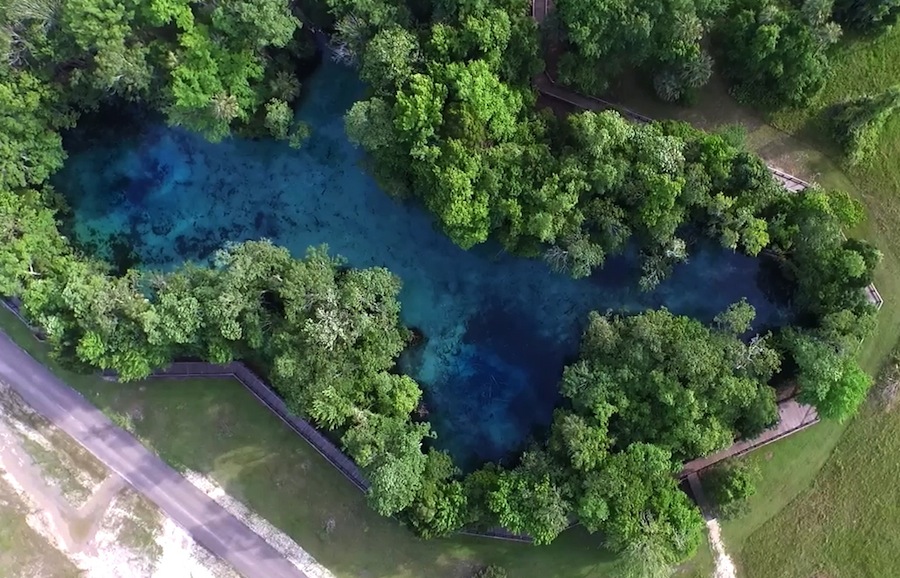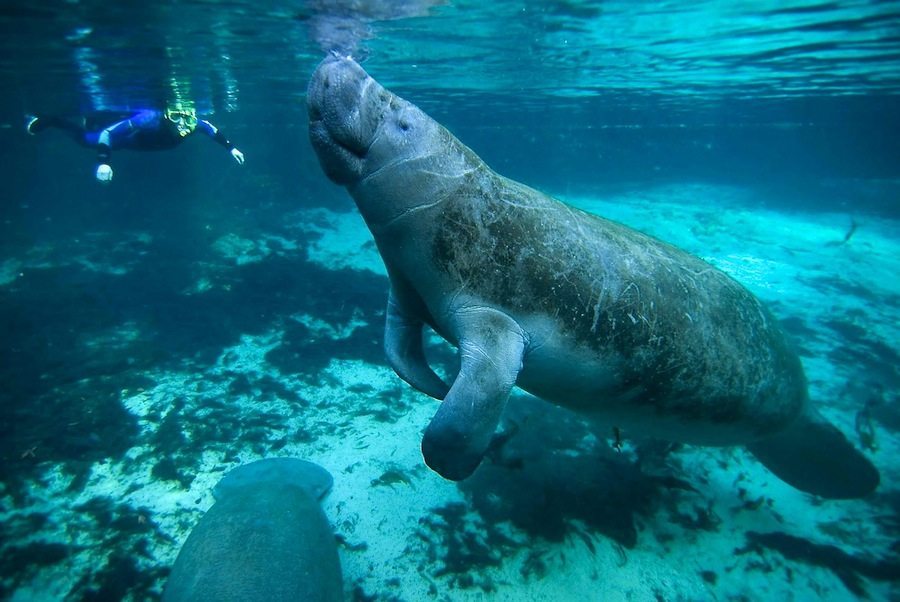Ever since I was a kid, I’ve been borderline obsessed with marine mammals but I certainly wasn’t unique in that sense; many children dream of becoming marine biologists when they grow up. In fact, for a good decade, I wanted nothing more than to work as a marine mammal trainer at SeaWorld. Oh, how times have changed! While my stance on animal captivity has taken a 360-degree turn, my love for ocean life hasn’t faltered.
So, this is where Plantation on Crystal River comes into play. Not only does the plantation operate as an upscale hotel, but they also have an on-site adventure center where guests can rent kayaks or, even better, take an interactive manatee tour where you can observe these animals in the wild. Here’s a rundown of their tour and other interesting developments happening in Citrus County relating to manatee preservation. More below!
Where is Crystal River and why is it so special?
In my opinion, Crystal River is Florida’s best kept secret. This small town in Citrus County, Florida is the natural home to thousands of West Indian manatees. In particular, The Three Sisters Springs, which is a network consisting of vents, sand boils and crystal clear water. The major draw is that the springs have 72 degree Fahrenheit water year-round, which becomes extra important to Manatees come winter. Since manatees are sensitive to cold water, they flock to Crystal River as a warm-water oasis. You can see these lovable creatures other all year round but anywhere from late November through early March is when most visitors plan their trips.
Crystal River’s history of manatees goes way back but in recent years, the population has grown considerably. The total number of manatees in Florida went up from 6,063 to 6,250 over the past year. A survey on January 12, 2016 found 758 in Kings Bay & Crystal River and 1042 in Kings Bay and the Homosassa River. That was a new record for the area and, consistent with past years, constitutes one-sixth of Florida’s total manatee population. The record for manatees sheltering in the Three Sisters Springs complex at one time was 528.

Image via Citrus County
Is this safe for the manatees?
The first thing you should know is people in Crystal River are very, VERY serious about protecting the local manatees. This is something the county is really proud of, and rightfully so. In terms of legal matters, manatees are protected under two acts: the Marine Mammal Protection Act of 1972 and the Endangered Species Act of 1973. Basically, this means that it’s technically illegal to feed, harass, hunt or hurt a manatee in any way. I also want to stress that while snorkelers can interact with the manatees if and only if one approaches them, there are several areas roped off as sanctuaries and not accessible to the public. A rope might not sound like a huge barrier but people are almost always fined if they dare to cross it.
Over the course of my trip, I was genuinely surprised by how much these laws are enforced, not only by the Florida Fish & Wildlife Conservation Commission, but by regular citizens who call Crystal River home. Everyone, from volunteers monitoring tourist activity at Three Sisters Springs to the Plantation on Crystal River staff “gets” how serious it is to keep these animals safe. Of course, there are some that aren’t too keen on the whole manatee tourism boom, which I can respect. However, the manatee population continues to grow in Crystal River so something is obviously working! Education is key in keeping these animals safe and so far, that’s happening.

Image via Carol Grant/Visit Citrus
What is a tour like?
My tour departed right from Plantation on Crystal River’s adventure center bright and early. There are many companies that offer manatee tours but I recommend this particular tour for several reasons. Firstly, the guides are well-trained and truly passionate about their jobs. You might think that’s a given, but you’d be surprised. Secondly, their wetsuits are made of a higher quality material that promotes more buoyancy in the water. This was my first time slithering into a wetsuit so I really have nothing to compare it to but I did find it easy to stay near the surface of the water while wearing one.
On most days, there’s an early morning tour (about 7am) and an afternoon tour. Usually, it’s recommended to do the morning tour based on the water temperature and the tides. Before entering the boat, groups are required to watch a safety video about “passive observation.” While I feel like many of these rules (i.e. no kicking) should be common sense, I still appreciated the reminder. Then, during the boat ride to Kings Bay and the surrounding area, there’s a good amount of briefing about how to swim near a manatee, when not to swim over one (when they’re sleeping) and other little tidbits to make the experience a comfortable one for both the snorkeler and the manatee.
I should note here that even though I visited Crystal River during prime manatee season (the winter months) and in the morning, I didn’t see a ton of manatees. This, by no means, took away from my trip but I also want to keep one’s expectations in check. Crystal River is a natural environment and these are wild animals, so it’s impossible to predict anything. For this reason and due to poor visibility, some of these photos are not ones I took myself.

Do I have to get in the water?
If you’re on the fence about taking a manatee tour, there are a few things to know ahead of time. It’s not a pre-requisite to get in the water. There was a nice family from Germany on my tour who treated it as a boat ride. That’s always an option. If you decide to give snorkeling a try, remember that you can always enter the water with a noodle for added buoyancy. The most important thing is to practice “passive observation.” We weren’t even flippers because splashing is discouraged, as it can easily frighten the manatees away. I’d suggest either sticking close to your guide or float near the boat’s ladder. Even if you don’t snorkel, you’ll still see lots from the boat.
Not much of a swimmer? No problem! There are plenty of other ways to learn about manatees without getting wet. The Homosassa Springs Wildlife State Park has six resident manatees in their care that are not able to survive in the wild. Visitors can swing by to see manatees, along with more than 200 other animals native to Florida, year-round. There’s also an educational program offered daily.
I also recommend going to Three Sisters Springs and walking along the trail that overlooks the sanctuary. It’s relatively new, well-maintained and ideal for picture-taking. When I stopped by, there were about twenty of so manatees gliding quietly through the super clear spring water. During certain parts of the days when the manatees venture outside the spring in search of food, kayakers and snorkelers can enter the spring. Otherwise, they’ll need to stay outside the sanctuary rope.

Image via Carol Grant/Visit Citrus
What will you learn?
Having now swam with manatees in Crystal River, I can say with sincerity that I’m still no expert. BUT, I did learn quite a few fun facts about these amazing creatures. One that surprised me had to do with their body weight. I assumed that manatees had a considerable amount of blubber but they actually don’t. This is likely why they are so sensitive to cold water and love the warm springs so much. Manatees also have a finger-like skeleton underneath their flippers, kind of like us. Adults weigh between 900 and 1200 in the wild and a lot more in captivity. Oh, and they’re vegetarian! On a normal day, they can eat anywhere between 10-15% of their body weight.
Another interesting thing about manatees is that they don’t have any real predators. In fact, their biggest predators are boats. Speaking of which, there’s now a speed limit in place for any boats sailing through Kings Bay and Crystal River and it’s strictly enforced. I saw a few manatees with some pretty rough-looking scars from previous boat accidents so I’m really happy by this new law. Another threat is the loss of habitat and Crystal River is already working on a solution for that. Right now, they are growing eelgrass in hopes of feeding the growing manatee population. Assuming that pilot program goes well, there’s lots more where that came from!

Image via Plantation on Crystal River
What’s your favorite animal? Tell me in the comments below!
This post is in collaboration with Hayworth PR, Plantation on Crystal River and Citrus County. All opinions are my own.

Megan Eileen McDonough is writer, blogger and social media specialist based in New York City. She also runs Bohemian Trails, a lifestyle blog designed for the savvy and stylish traveler. Bohemian Trails aims to feature must-see places around the world, covering everything from revamped neighborhoods and vibrant street art to innovative tech hubs and everything in between. Her cultural escapades have taken her to Latin America, Asia, Europe, and the Middle East.
Megan is also a freelance writer and social media specialist based in New York City. She contributes to various online and print publications in the travel and fashion industries and is an international correspondent for both Jetsetter and Northstar Travel Media.








